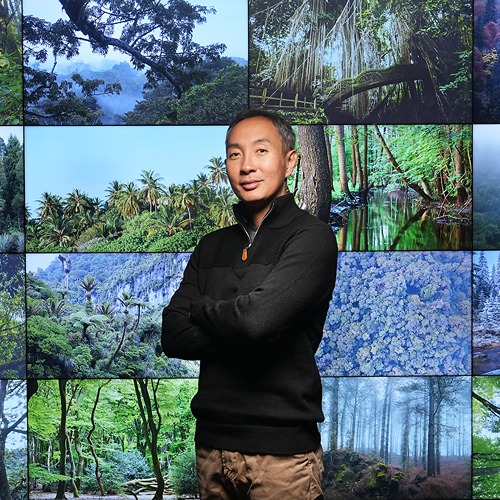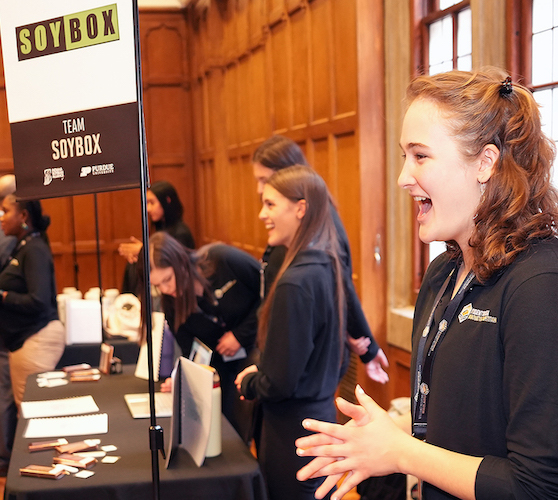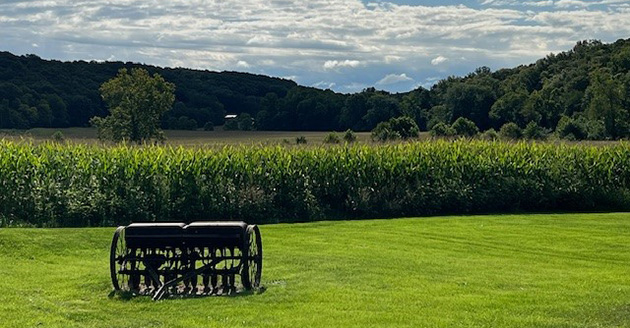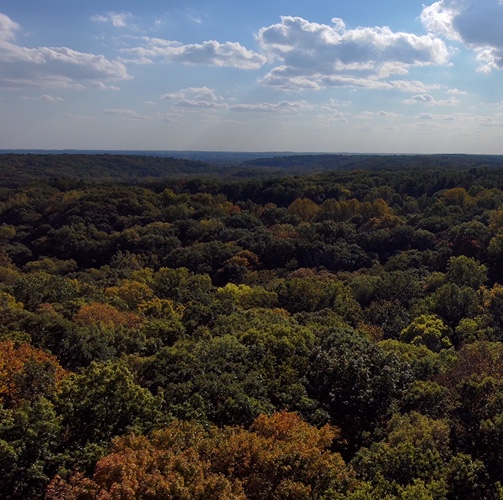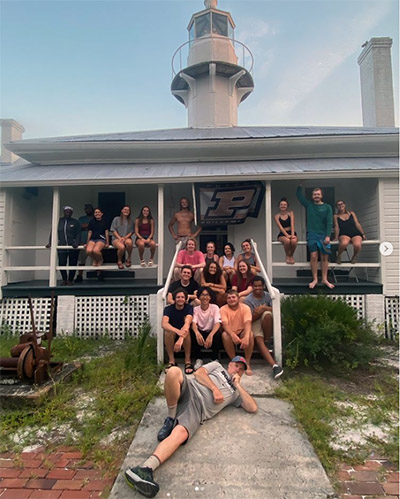 Students in the Marine Biology Practicum class (FNR 378000) spent 11 days before the fall semester began, gaining hands-on training at the Seahorse Key Marine Lab in Florida. The trip allows students to learn and use field techniques to sample Gulf of Mexico marine habitats and organisms, before returning to meet for eight weeks on campus to process and report on what they learned.
Students in the Marine Biology Practicum class (FNR 378000) spent 11 days before the fall semester began, gaining hands-on training at the Seahorse Key Marine Lab in Florida. The trip allows students to learn and use field techniques to sample Gulf of Mexico marine habitats and organisms, before returning to meet for eight weeks on campus to process and report on what they learned.
In addition to participating in the hands-on activities in Seahorse Key, students were required to keep a field journal of experiences to keep track of species, techniques and pertinent illustrations of both for documentation and future practical use. A group field report documenting findings also is included in the curriculum.
Drs. Reuben Goforth and Rado Gazo, teaching assistants Audree Neely, Riley Thompson and Ben Szczygiel and the group of 17 students stayed in the historic lighthouse on Seahorse Key, an island a few miles from the Gulf Coast of Florida, and worked out of a specimen lab operated by the University of Florida.
After arriving in Gainesville, Florida on August 7, students were shuttled to Cedar Key, where they were introduced to the Seahorse Key Marine Lab to begin their 11-day stay, which included field sampling skills from pivot and straight-haul beach seining to cast nets, crab pots, hook-and-line sampling, quadrat sampling, transect sampling, otter trawl, microplastics sampling and sub-benthic sampling.
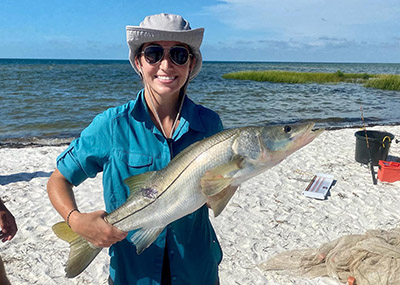 “We learned so many different things that are important in this field,” said Megan Merryman, a senior double majoring in wildlife and aquatic sciences-marine and freshwater biology. “We learned how to properly conduct many different sampling methods and properly take data, along with how to safely remove the animals caught with certain methods. We learned things at all different levels, starting from seagrass all the way up to apex predators such as sharks. We also practiced tagging and learned how research can be done on different species. I think the thing I will take away most is the hands-on interactions I had with so many different species. Seeing them in class on campus is nothing compared to seeing them in the field and in their own habitat. It gave me a whole different perspective and I will never forget this experience.
“We learned so many different things that are important in this field,” said Megan Merryman, a senior double majoring in wildlife and aquatic sciences-marine and freshwater biology. “We learned how to properly conduct many different sampling methods and properly take data, along with how to safely remove the animals caught with certain methods. We learned things at all different levels, starting from seagrass all the way up to apex predators such as sharks. We also practiced tagging and learned how research can be done on different species. I think the thing I will take away most is the hands-on interactions I had with so many different species. Seeing them in class on campus is nothing compared to seeing them in the field and in their own habitat. It gave me a whole different perspective and I will never forget this experience.
“This experience really showed me that I want to work in a hands-on career where I can actually interact with different animals. I have always had an interest in sharks and this experience really set in stone my love for those animals. I would absolutely love to find a job working with sharks. I think this practicum really gave insight into how fieldwork actually gets done. In this setting, we experienced the uncertainties that come with fieldwork. Things like waiting for certain tides, not catching fish in certain areas, equipment changes, and weather changes. Knowing that fieldwork can change on a dime and you have to be ready for anything and patient at the same time is very important going into choosing a career. I now have the experience to make the best decision I can for a career.”
Lessons not only included sampling skills, but also professional development skills.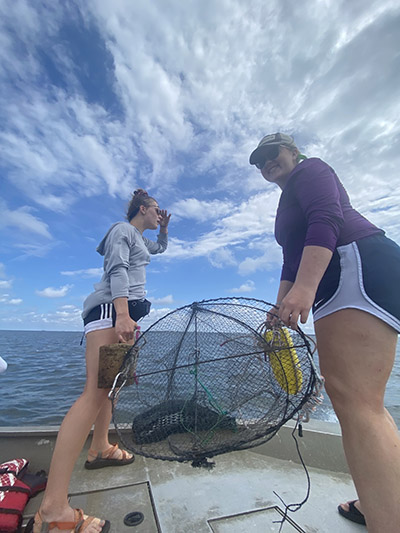
“I learned a lot about working with people I don't know that well, having to work with a flexible schedule with unpredictable conditions, and animal handling,” said Emily Ragsdale, a senior double majoring in wildlife and aquatic sciences-marine and freshwater biology. “This experience made me realize I love working in the field, and that it's very rewarding when you have a successful day doing so. I would love to be able to work in research, with more time in the field.”
Practicum experiences gave students exposure to the realities of field work, both good and bad, from amazing encounters with wildlife to heat, humidity and insects.
“My favorite experience at the marine biology practicum was when we went quadrat sampling for scallops. It was a great experience to get out on the water and dive to try to find scallops and sea urchins,” said Luke Neville, a junior aquatic sciences-marine and freshwater biology major. “I learned a lot about fieldwork and what it takes to be outside every day collecting samples. I also learned that you must be flexible to the weather and other variables that pop up at any moment that can change your plans. This experience changed my career goals because after this I really want to learn more about and work with marine life and marine ecosystems.”
Junior aquatic sciences-marine and freshwater biology major Yang Liu was unsure at the beginning of the trip, but had a great experience in the end.
“The environmental conditions were so bad, I wanted to go home when I first arrived,” Liu said. “Things I learned on this trip were not only knowledge, but also how to get along with my friends and how to deal with bad environmental conditions. Life there (at practicum) was very fun. I enjoyed the fieldwork experience. Dr. Goforth did a great job on the trip. He is patient, kind, knowledgeable and humorous. When we were about to leave, my mind was totally the opposite compared to when we first arrived, I wanted to stay there for a longer time.”
 A collage of the Marine Biology Practicum students in action in Seahorse Key, Florida. Top row (Left to Right): Hook-and-line sampling off the dock (pictured: front to back- Kaitlyn Sinclair, Megan Merryman, Erikka Ededuwa, Noah Ehmen, and Emily Ragsdale); Megan Merryman snorkeling for sea urchins and scallops; Rachel Kraus with a bluntnose stingray; Isaac Jones with a redfish and hardhead catfish on the line; Emily Ragsdale with a shark. Row 2 (L to R): Megan Merryman with a stingray; Grace "Trip" Newton with a spanish mackerel she caught hook and line sampling; Dr. Reuben Goforth with a sea turtle; Emma Engel with a bonnet head shark; Noah Ehmen with a white fin shark sucker. Row 3: Teaching assistant Riley Thompson with a shark. Bottom row: (L to R): A student takes a picture from the boat; students measure a fish alongside Dr. Reuben Goforth; Luke Neville with a stingray; Newton with a hardhead catfish she caught; students along with Dr. Rado Gazo on a boat.
A collage of the Marine Biology Practicum students in action in Seahorse Key, Florida. Top row (Left to Right): Hook-and-line sampling off the dock (pictured: front to back- Kaitlyn Sinclair, Megan Merryman, Erikka Ededuwa, Noah Ehmen, and Emily Ragsdale); Megan Merryman snorkeling for sea urchins and scallops; Rachel Kraus with a bluntnose stingray; Isaac Jones with a redfish and hardhead catfish on the line; Emily Ragsdale with a shark. Row 2 (L to R): Megan Merryman with a stingray; Grace "Trip" Newton with a spanish mackerel she caught hook and line sampling; Dr. Reuben Goforth with a sea turtle; Emma Engel with a bonnet head shark; Noah Ehmen with a white fin shark sucker. Row 3: Teaching assistant Riley Thompson with a shark. Bottom row: (L to R): A student takes a picture from the boat; students measure a fish alongside Dr. Reuben Goforth; Luke Neville with a stingray; Newton with a hardhead catfish she caught; students along with Dr. Rado Gazo on a boat. Students were exposed to various professions in the marine environment, which helped to shape future plans for some.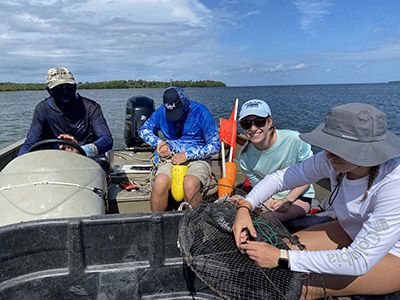
“Marine biology practicum taught me a variety of skills including surveying methods in a marine environment and identification of marine organisms. I also learned about possible future careers or pathways post-undergrad,” said Rachel Kraus, a senior wildlife major with minors in aquatic sciences and forest ecosystems. “This experience changed my career goals because I am heavily interested in working in a marine ecosystem now. I am a wildlife major with a minor in aquatic sciences, and the marine biology practicum really encouraged me to look more into careers within a marine ecosystem. Marine environments are extremely diverse, and are always needing help in conservation, which interests me into looking down that pathway.”
Each student had a favorite moment or experience that impacted them.
“My favorite experience at marine biology practicum was performing quadrat sampling and snorkeling for scallops off the coast of Steinhatchee, Florida,” Ragsdale said. “I enjoyed being able to try something I had  never done before, especially in an area away from where we had been working. I also liked that everyone was able to work at the same time rather than taking turns.”
never done before, especially in an area away from where we had been working. I also liked that everyone was able to work at the same time rather than taking turns.”
Neville also enjoyed the quadrat sampling, which involves setting up a series of squares across a habitat of interest and then identifying and recording the species found within the individual quadrats.
“My favorite experience at the marine biology practicum was when we went quadrat sampling for scallops,” Neville said. “It was a great experience to get out on the water and dive to try to find scallops and sea urchins.”
Kraus could not choose just one experience as her favorite.
“One of my favorite experiences was performing quadrat surveys for sea urchins and bay scallops, because I was able to understand the struggle of marine surveying,” Kraus said. “We had difficultly swimming with the current in some areas. However, I also found how enjoyable it can be, because it is not every day that you get the chance to snorkel in the ocean for sea urchins and scallops. Another favorite experience I had  was learning about shark and ray surgery methods through Georgia Southern University professor Dr. (Christine) Bedore, and her master’s student, Chessy. They showed us how to perform a liver biopsy on sharks and rays to test it for pollutants within the environment through what they are eating. It was an amazing experience to see surgery performed on these organisms, and then to see them released back into the wild.”
was learning about shark and ray surgery methods through Georgia Southern University professor Dr. (Christine) Bedore, and her master’s student, Chessy. They showed us how to perform a liver biopsy on sharks and rays to test it for pollutants within the environment through what they are eating. It was an amazing experience to see surgery performed on these organisms, and then to see them released back into the wild.”
The experience of watching and learning from Dr. Bedore also impacted Megan Merryman.
“My favorite experience was getting to learn about sharks and elasmobranchs from Dr. Bedore,” Merryman said. “She gave me experience with sharks that I have never had, but always wanted! We also learned how to safely handle different elasmobranchs, got insight into the research being done on these species, and got to watch actual surgery on the animals, which made the experience even better. I also loved the day we went snorkeling for scallops. That day was a lot of fun and I got to see scallops actually swim, which was a first for me!”
Grace “Trip” Newton also enjoyed learning about elasmobranchs, a subclass of fish, which includes sharks, rays, skates and sawfish.
“I really enjoyed all the elasmobranch stuff we did,” Newton said. “It's one thing to learn about these sensory systems using anatomical diagrams and theoretical concepts but things like seeing the animals respond to different metal types was interesting. I think my goals are more narrowed now. Before I was just wanting to work in conservation in general, but now I have a few more specialized subjects in mind, such as the sensory systems we learned about.”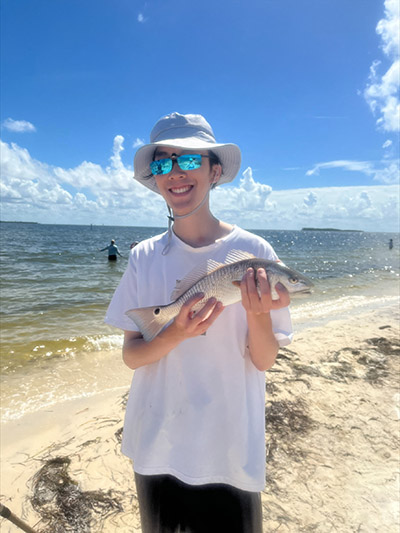
For some students who were newer to marine biology, like Yang Liu, the trip offered them their first taste of life on the water.
“My favorite moment of the trip was hook and line sampling; that was actually my first time fishing,” Liu said. “It is very pleasant to feel the fish biting the hook. In the first day of hook and line sampling, my friends taught me how to put on the lure and how to cast. It is mostly a sit and wait fishing technique, so it was kind of boring at first and I started to doubt if there were really fish in there. However, when I got a fish bite on my hook and I reeled it in, it was a Red Drum. Since then, I really like to do hook and line sampling to feel the fish bite.”
Through both time at Seahorse Key and in class back in West Lafayette, students were exposed to the proper care and use of field sampling gear as well as identification of fish and invertebrates from a variety of habitats. They learned practical skills and developed critical thinking and writing skills related to marine biology, which could impact them long past when the course ends.
“Experiential learning is critical for students interested in field-based careers, and my goal is to provide students with opportunities to develop skills while gaining relevant experience in a challenging environment,” Goforth said. “Marine biology is attractive to students who value biodiversity and its conservation due to the incredible diversity of marine ecosystems. However, students need to understand that conducting field research in marine biology is not easy, often requiring long, strenuous workdays in challenging environmental conditions. Providing this experience for students from a university in a land-locked state is even more critical, as many of my students have had very limited or even no experience with marine environments. I have offered this course for 10+ years, and the excitement and engagement of my students as they participate is both gratifying and inspiring. I feel extremely fortunate to have the opportunity to allow FNR students to get wet and dirty at the biologically rich and unique Seahorse Key Marine Lab in the Gulf of Mexico!”
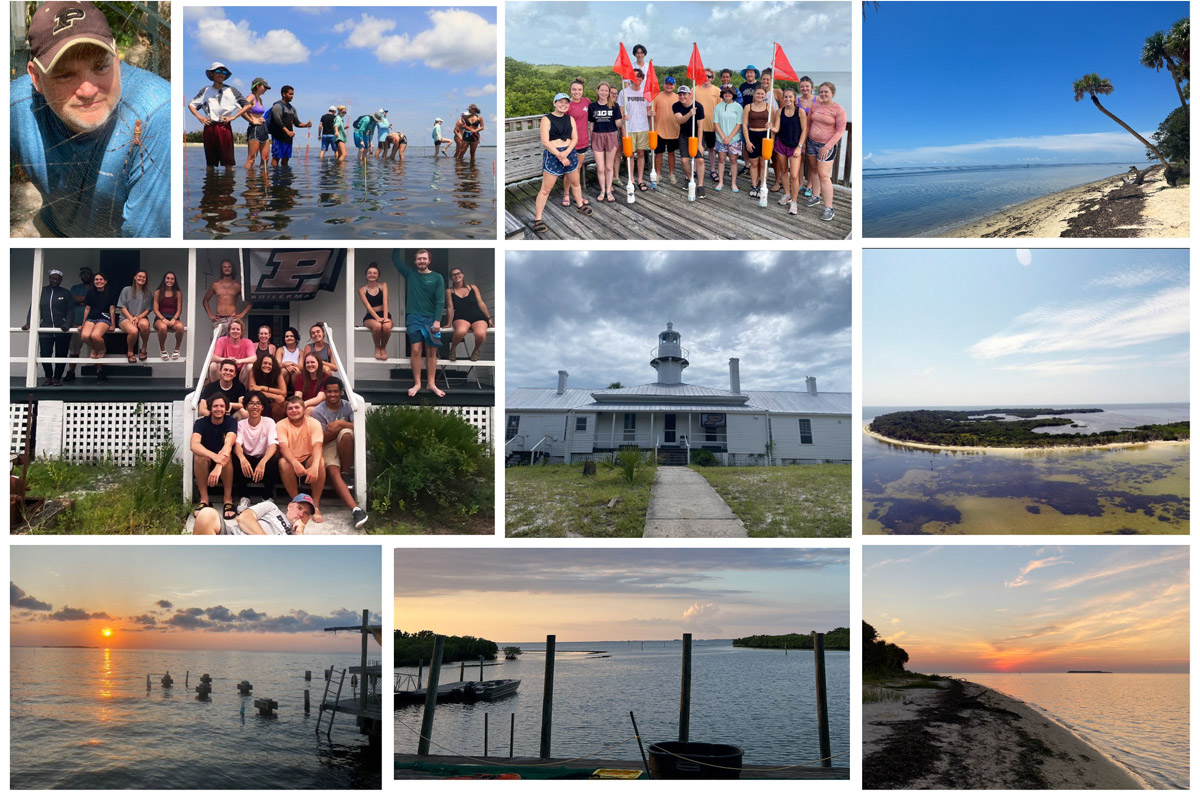 A collage of views from Marine Biology Practicum in Seahorse Key, Florida. Top row (Left to Right): Dr. Reuben Goforth with a spider web; students participating in a quadrat sampling exercise; students with the gillnet buoys they made at practicum; a view of the island from Yang Liu. Row 2 (L to R): The 2022 practicum group with Dr. Reuben Goforth; the historic lighthouse on Seahorse Key where the group stayed; Seahorse Key from a drone. Row 3 (L to R): A sunset on seahorse key; dusk on the water; a sunset photo by Emily Ragsdale.
A collage of views from Marine Biology Practicum in Seahorse Key, Florida. Top row (Left to Right): Dr. Reuben Goforth with a spider web; students participating in a quadrat sampling exercise; students with the gillnet buoys they made at practicum; a view of the island from Yang Liu. Row 2 (L to R): The 2022 practicum group with Dr. Reuben Goforth; the historic lighthouse on Seahorse Key where the group stayed; Seahorse Key from a drone. Row 3 (L to R): A sunset on seahorse key; dusk on the water; a sunset photo by Emily Ragsdale. 